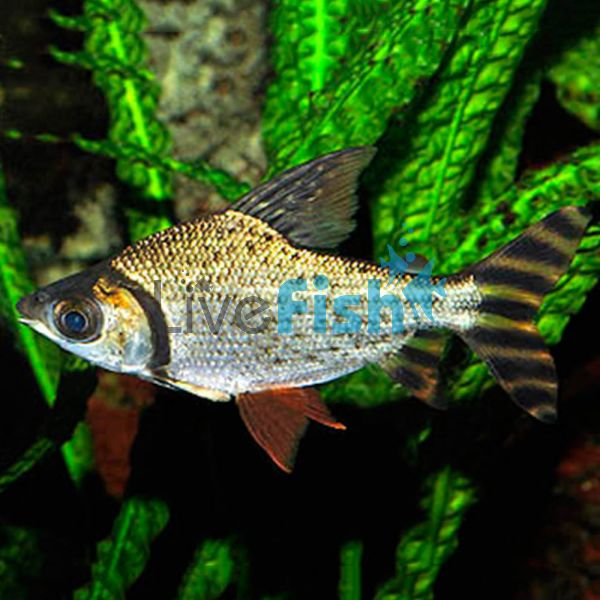Flagtail Prochilodus Red Finned 8cm
Flagtail Prochilodus is easily one of the best fish to add to a large aquarium. These fish are peaceful, reach around 30 cm long, are great algae eaters, and offer contrasting colours. Commonly found in South America the flag tail is usually on the must-have list of fish for larger aquariums, their peaceful temperament means they can be kept in groups and they won’t pick a fight with any other tank mates. Other aggressive tank mates tend to leave the flag tail alone because of its large and stocky size making it a ‘win-win’ situation. For a further challenge, these flag tails are wild caught which means a little bit more care is required when settling this fish into captive life.
Flagtail Prochilodus Red Finned
Flagtail Prochilodus is easily one of the best fish to add to a large aquarium. These fish are peaceful, reach around 30 cm long, are great algae eaters, and offer contrasting colours. Commonly found in South America the flag tail is usually on the must-have list of fish for larger aquariums, their peaceful temperament means they can be kept in groups and they won’t pick a fight with any other tank mates. Other aggressive tank mates tend to leave the flag tail alone because of its large and stocky size making it a ‘win-win’ situation. For a further challenge, these flag tails are wild caught which means a little bit more care is required when settling this fish into captive life.
Flagtail Prochilodus is also popular for its unique and contrasting coloration. They have a shining, silver belly that leads up to a gold back. The scales look like small diamonds under aquarium lighting and have speaking of black spots throughout as well. The Flagtail Prochilodus gets its name from the characteristic orange and black stripes found on the tail fin that is quite bold. This deep orange colour is also seen on the other fins as well. As these flag tails come from the wild, they may be quite timid when being introduced and may not take to prepared aquarium foods readily. It is usually best to keep these fish in a quarantine tank where they can be treated for potential internal parasites and to ensure they are eating well before being moved to a larger display aquarium.
Breeding Flagtail Prochilodus in the home aquarium has not been recorded since these fish migrate long distances in the wild to breed. The home aquarium simply does not offer this ability. These are fish that are best enjoyed in the display aquarium rather than in a breeding project.
Tank Recommendations for your Flagtail Prochilodus
Since the Flagtail Prochilodus will reach around 30 cm and are a stocky fish, it is best to keep them in a tank of around 450 liters. These are also relatively active so the large aquarium is a must. Flagtails are the perfect mid-water fish so they are not too concerned about the substrate of hardscape choices.
An ideal setup would be to have a sandy substrate with large, smooth river stones and driftwood as this creates great surfaces for algae growth. Flagtails are a big herbivore however they cane kept with most rough-leafed plants like Anubis or java fern. Avoiding any fine-leafed plants is best as these may become a meal. Flagtail Prochilodus is a tropical fish that will prefer temperatures between 24 - 27 degrees.
Suitable Tank Buddies
Flagtail Prochilodus can be kept together in groups or solitary. They are very peaceful fish that is almost like a big water cow, preferring to go the herbivore route with food. There is still a small risk with very small and slow-moving fish so these should be avoided.
Usually Compatible
Ghost Knife fish, yoyo loach, clown loach, silver dollars, Jack Dempsey, and similar larger species.
Sometimes Compatible
Black widow tetras, Midas cichlids, Oscars, festae, peacock bass, and other large but more aggressive species. Though they may not be able to eat the Flagtail, there is a risk of long-term stress but this is not too common.
Rarely Compatible
Cardinal tetras, Pygmy Corydoras, guppies, and any other nano fish.
Feeding your Flagtail Prochilodus
Since these are wild flagtails they may not take to pellets right away, so it is best to start them on invert-based live foods like black worms or earthworms. They can then be transitioned to frozen foods and finally herbivore-based pellets.
| Scientific Name | Semaprochilodus taeniurus |
|---|---|
| Care Level | Hard |
| Common Names | Flagtail prochilodus |
| Diet | Herbivore |
| Fish Family | Prochilodontidae |
| Lifespan (years) | 10 |
| Max. Length (cm) | 30 |
| Min. Tank Volume (l) | 450 Litres |
| Origin | South America |
| Reef Safe | With Caution |
| Sociability | Peaceful |
| Venomous | No |
| Water Conditions | 24-26° C, pH 6.0-7.0 |




